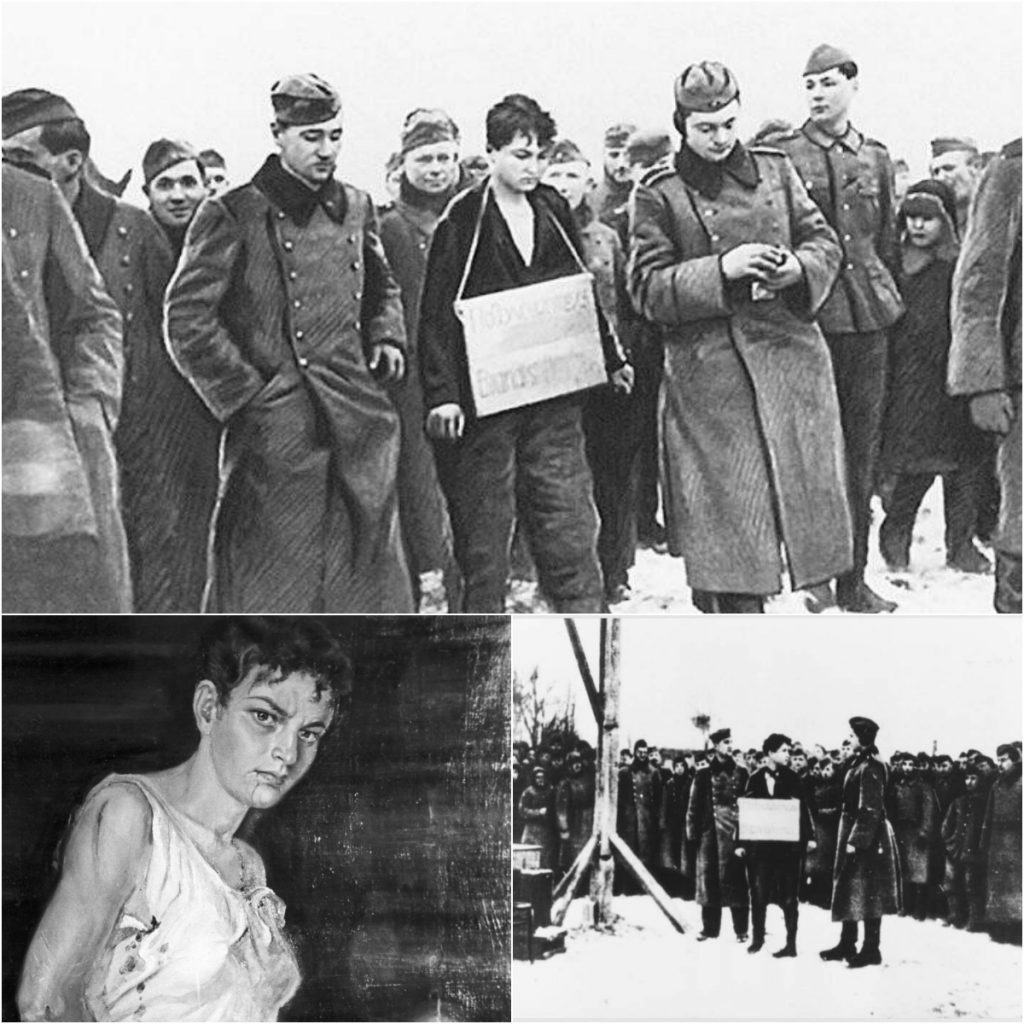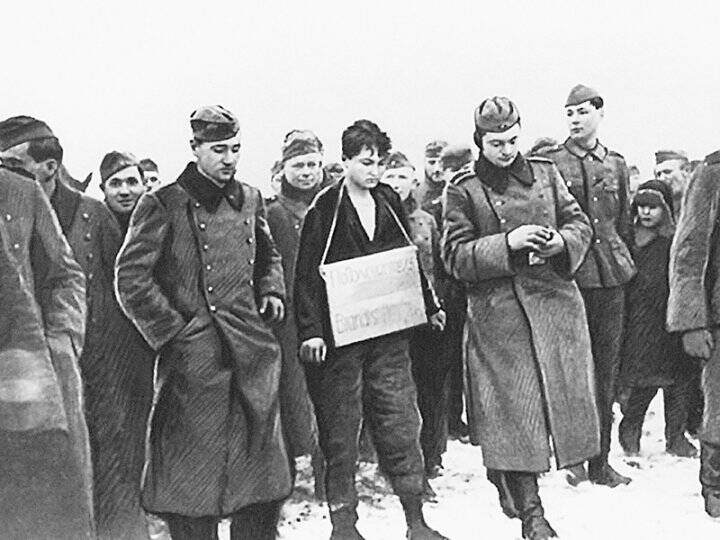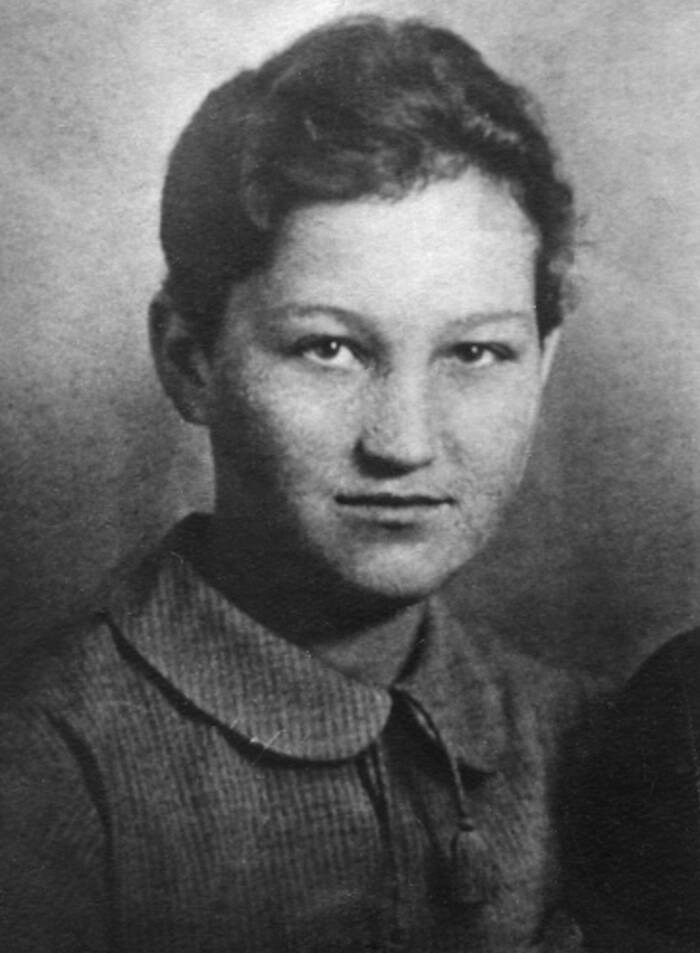The Fire That Refused to Die
In the frozen winter of 1941, when fear and despair blanketed much of Europe, a young girl named Zoya Kosmodemyanskaya became the face of courage. At only 18 years old, she stood before her Nazi captors, broken in body but unshaken in spirit. Her words—“It is happiness to die for one’s people”—were not just a farewell; they were a prophecy. A message that would outlive her, echoing across generations as a reminder of what defiance truly means.
A Humble Beginning in a Shifting World
Born in September 1923 in a quiet village near Moscow, Zoya grew up in a home filled with warmth, love, and an unshakable belief in education and service. Her father, a seminary student turned teacher, and her mother, a devoted educator, raised her and her brother Alexander in a world constantly reshaped by political upheaval.

The family’s peaceful life fractured during the Soviet collectivization policies, when tragedy struck with the murder of her grandfather. They fled to Siberia to escape persecution before finally settling in Moscow. There, tragedy struck again—Zoya’s father passed away when she was just ten years old, leaving her mother to raise two children alone.
Through hardship, Zoya’s determination hardened like steel. She poured her heart into her studies, joining youth organizations such as the Pioneers and later the Komsomol. These movements shaped her ideals of service, sacrifice, and patriotism—values that would soon define her destiny.
The Call to Arms: A Girl Against an Empire
When Nazi Germany launched Operation Barbarossa in June 1941, it was more than just an invasion—it was an apocalypse. Cities burned, families vanished, and millions of Soviet citizens faced unimaginable suffering.
Zoya, then a high school senior, could have stayed in safety. But that wasn’t her way. She volunteered for the partisan resistance, cutting her hair short and disguising herself as a young man named “Tanya.” Her missions were perilous—sabotaging German communications, setting fire to enemy barracks, and cutting supply lines that crippled Nazi movements.
Video : (Rare) The internationale | Funeral of Zoya Anatolyevna Kosmodemyanskaya | February 1942
It wasn’t about glory or fame. For Zoya, it was simple: her homeland was bleeding, and she refused to stand by.
Captured in the Cold: The Night of Betrayal
In late November 1941, Zoya’s group was ordered to burn houses in the village of Petrishchevo, which the Nazis had commandeered. Under the shadow of night, she crept through the snow, torch in hand. But someone betrayed her.
The next morning, German soldiers captured her. What followed was a series of tortures that would have broken most people. She was beaten, burned, and paraded through the freezing streets barefoot. Still, she refused to give her real name. She wouldn’t betray her comrades. To her captors, she was simply “Tanya”—a ghost of resistance they couldn’t silence.
Before the Gallows: Words That Changed History
On November 29, 1941, Zoya was dragged to the village square. A crude wooden gallows stood waiting. A sign hung around her neck read “Guerrilla.” But instead of tears, she gave them words that would echo through eternity.

“Comrades! Do not be afraid! Fight them! Burn their homes!” she shouted. Then, turning to her executioners, she declared, “You hang me now, but I am not alone. There are two hundred million of us—you cannot hang everyone!”
Her final cry—“Goodbye, comrades!”—ripped through the icy air as the rope tightened. The crowd wept. Even some German soldiers turned away.
At that moment, Zoya wasn’t just a girl facing death. She became a symbol of immortal defiance.
The Legend Spreads Across the Nation
News of her execution spread like wildfire. Soviet journalist Pyotr Lidov published an article titled “Tanya”, describing her bravery. Soon, her true identity was revealed, and the Soviet Union embraced her as a national hero.
Monuments rose in her honor. Schools and streets bore her name. Children learned her words by heart. In February 1942, she was posthumously awarded the title Hero of the Soviet Union, the nation’s highest honor. Her brother Alexander would later receive the same award after falling in combat—two siblings bound forever by sacrifice.
Through the decades, Zoya became the embodiment of resistance—the young face of a country that refused to kneel.

A Legacy Questioned but Never Diminished
In the post-Soviet years, her story faced skepticism. Some historians questioned the official accounts, suggesting inconsistencies in the details of her mission and capture. Was she truly targeting Nazis, or were local villagers the unintended victims of a scorched-earth order? Did propaganda shape her legend more than truth?
Yet even amid debate, one fact remained unshakable: her courage was real. Whether or not every tale was perfectly accurate, the essence of her defiance was undeniable. She had stood against tyranny with nothing but conviction—and that was enough to make her eternal.
Zoya’s Eternal Flame
More than 80 years later, Zoya Kosmodemyanskaya’s name still burns bright in the pages of history. She was not a soldier by rank, nor a leader by title. She was something far more powerful—an ordinary young woman who chose extraordinary courage.
Her story reminds us that true heroes are not born in palaces but in moments of fear, when standing tall means standing alone. Zoya’s voice, echoing through snow and silence, continues to whisper across time: “I’m not afraid to die for my people.”
Video : The BRUTAL Execution Of Zoya Kosmodemyanskaya – The Teenage Girl Executed By The Nazis
Conclusion: The Spirit That Defied the Darkness
Before the gallows, a legend was born—a legend that no rope could silence. Zoya Kosmodemyanskaya’s life was brief, but her fire never went out. Her defiance became the heartbeat of a nation, her words a torch that lights the conscience of humanity.
She reminds us that bravery doesn’t come from strength—it comes from belief. From choosing to act, even when the world trembles. And as long as people remember her name, the flame she lit on that frozen morning in 1941 will never die.